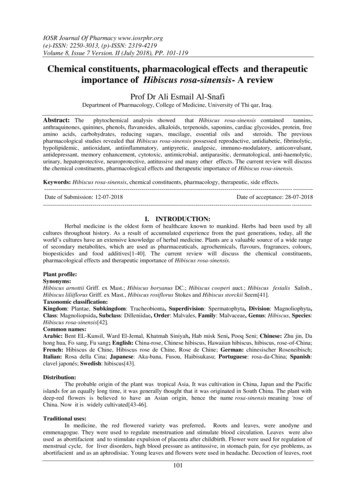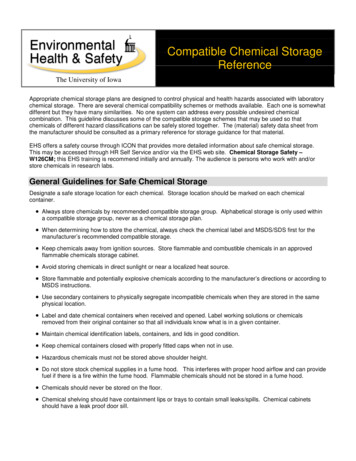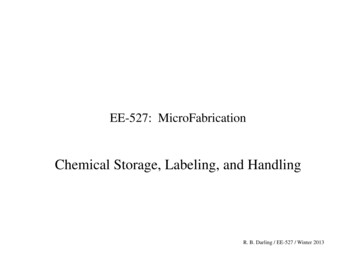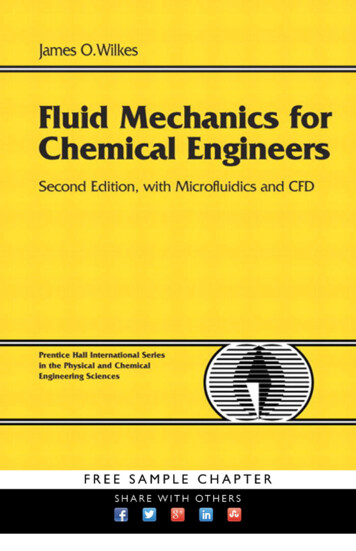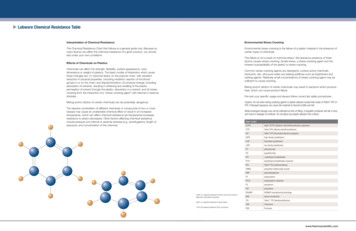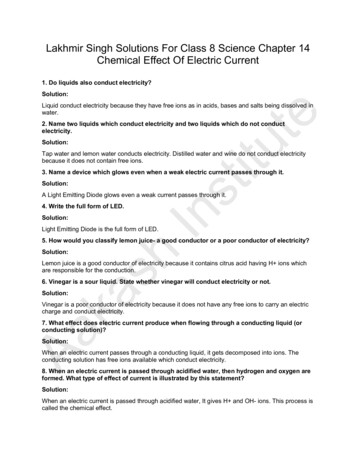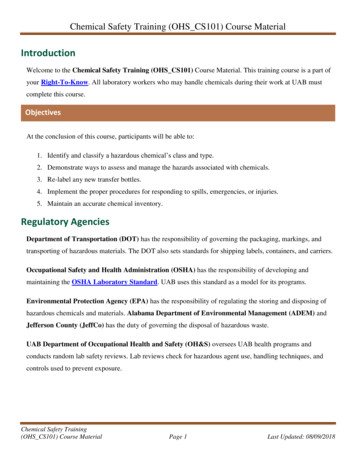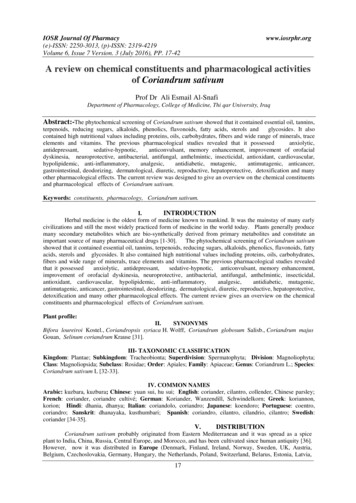
Transcription
IOSR Journal Of Pharmacy(e)-ISSN: 2250-3013, (p)-ISSN: 2319-4219Volume 6, Issue 7 Version. 3 (July 2016), PP. 17-42www.iosrphr.orgA review on chemical constituents and pharmacological activitiesof Coriandrum sativumProf Dr Ali Esmail Al-SnafiDepartment of Pharmacology, College of Medicine, Thi qar University, IraqAbstract:-The phytochemical screening of Coriandrum sativum showed that it contained essential oil, tannins,terpenoids, reducing sugars, alkaloids, phenolics, flavonoids, fatty acids, sterols andglycosides. It alsocontained high nutritional values including proteins, oils, carbohydrates, fibers and wide range of minerals, traceelements and vitamins. The previous pharmacological studies revealed that it ic,anticonvulsant, memory enhancement, improvement of orofacialdyskinesia, neuroprotective, antibacterial, antifungal, anthelmintic, insecticidal, antioxidant, cardiovascular,hypolipidemic, anti-inflammatory,analgesic,antidiabetic, mutagenic,antimutagenic, anticancer,gastrointestinal, deodorizing, dermatological, diuretic, reproductive, hepatoprotective, detoxification and manyother pharmacological effects. The current review was designed to give an overview on the chemical constituentsand pharmacological effects of Coriandrum sativum.Keywords: constituents, pharmacology, Coriandrum sativum.I.INTRODUCTIONHerbal medicine is the oldest form of medicine known to mankind. It was the mainstay of many earlycivilizations and still the most widely practiced form of medicine in the world today. Plants generally producemany secondary metabolites which are bio-synthetically derived from primary metabolites and constitute animportant source of many pharmaceutical drugs [1-30]. The phytochemical screening of Coriandrum sativumshowed that it contained essential oil, tannins, terpenoids, reducing sugars, alkaloids, phenolics, flavonoids, fattyacids, sterols and glycosides. It also contained high nutritional values including proteins, oils, carbohydrates,fibers and wide range of minerals, trace elements and vitamins. The previous pharmacological studies revealedthat it possessedanxiolytic, antidepressant,sedative-hypnotic, anticonvulsant, memory enhancement,improvement of orofacial dyskinesia, neuroprotective, antibacterial, antifungal, anthelmintic, insecticidal,antioxidant, cardiovascular, hypolipidemic, anti-inflammatory,analgesic,antidiabetic, mutagenic,antimutagenic, anticancer, gastrointestinal, deodorizing, dermatological, diuretic, reproductive, hepatoprotective,detoxification and many other pharmacological effects. The current review gives an overview on the chemicalconstituents and pharmacological effects of Coriandrum sativum.Plant profile:II.SYNONYMSBifora loureiroi Kostel., Coriandropsis syriaca H. Wolff, Coriandrum globosum Salisb., Coriandrum majusGouan, Selinum coriandrum Krause [31].III- TAXONOMIC CLASSIFICATIONKingdom: Plantae; Subkingdom: Tracheobionta; Superdivision: Spermatophyta; Division: Magnoliophyta;Class: Magnoliopsida; Subclass: Rosidae; Order: Apiales; Family: Apiaceae; Genus: Coriandrum L.; Species:Coriandrum sativum L [32-33].IV. COMMON NAMESArabic: kuzbara, kuzbura; Chinese: yuan sui, hu sui; English: coriander, cilantro, collender, Chinese parsley;French: coriander, coriandre cultivé; German: Koriander, Wanzendill, Schwindelkorn; Greek: koriannon,korion; Hindi: dhania, dhanya; Italian: coriandolo, coriandro; Japanese: koendoro; Portuguese: coentro,coriandro; Sanskrit: dhanayaka, kusthumbari; Spanish: coriandro, cilantro, cilandrio, cilantro; Swedish:coriander [34-35].V.DISTRIBUTIONCoriandrum sativum probably originated from Eastern Mediterranean and it was spread as a spiceplant to India, China, Russia, Central Europe, and Morocco, and has been cultivated since human antiquity [36].However, now it was distributed in Europe (Denmark, Finland, Ireland, Norway, Sweden, UK, Austria,Belgium, Czechoslovakia, Germany, Hungary, the Netherlands, Poland, Switzerland, Belarus, Estonia, Latvia,17
A review on chemical constituents and pharmacological activitiesLithuania, Moldova, Ukraine, Albania, Bulgaria, Greece, Italy, Romania, Yugoslavia, France, Portugal andSpain), Northern Africa (Algeria, Morocco, Tunisia and Ethiopia), Asia (Afghanistan, Iran, Iraq, Palestine,Jordan, Lebanon, Syria, Turkey, Armenia, Azerbaijan, Georgia, southern Russia, Kazakhstan, Kyrgyzstan,Tajikistan, Turkmenistan, Uzbekistan, China, India and Pakistan) [35, 37].VI.DESCRIPTIONIt is an upright and short-lived herbaceous plant usually growing 1-2 m. Stems and leaves: Thebranched stems are hairless (i.e. glabrous), mostly hollow, and have fine lengthwise (i.e. longitudinal) grooves.They are pale green in colour but covered in distinctive purplish or pinkish blotches. The alternatelyarranged leaves are borne on long hollow leaf stalks (i.e. petioles) that tend to sheath the stem at their bases.They are deeply divided (i.e. bi-pinnatisect), with toothed (serrate) segments, and are ferny in appearance. Theseleaves (up to 50 cm long and 40 cm wide, but more commonly 12-25 cm long) are hairless ( glabrous). Theupper leaf surfaces are dark green in colour, while their undersides are a paler green or greyish-green. The stemsand leaves give off a strong odour when crushed or damaged. Flowers and Fruit: The white flowers are borne inlarge numbers in dense flat-topped clusters at the tips of the branches (in terminal compound umbels). Individualflowers are small (2-4 mm across), have five incurved petals and five stamens, and are borne on stalks (pedicels)up to 5 cm long. Many (about 15) of these stalks (pedicels) radiate from the same point and form a small clusterof flowers (an umbel), with several (6-20) of these smaller clusters (often called rays) being grouped togetherinto a much larger cluster (a compound umbel) that is subtended by several small leafy bracts (about 5 mm long).Flowering occurs mostly during spring and summer. The fruit turns from green to greyish-brown in colour as itmatures and resembles a capsule. It actually consists of two one-seeded structures (mericarps) that readilysplit apart when the fruit is fully mature. Each of these (seeds), 2-4 mm long, hairless ( glabrous), but has fiveprominent yellowish-coloured ribs. There are many varieties of Coriandrum sativum which differ in the fruitsize and oil yield [36-39].VII.TRADITIONAL USES:The use of coriander dated back to around 1550 BC, and it was one of the oldest spice crops in theworld. Medicinally, it was used as stimulant, aromatic and carminative. The powdered fruit, fluid extract and oilare chiefly used medicinally as flavouring to disguise the taste of active purgatives and correct their gripingtendencies. The whole or ground seed (fruit) was an ingredient of pickling spices, also used to flavor variouscommercial foods, particularly, to prepare some instant soups and dishes, in many cakes, breads and otherpastries, alcoholic beverages, frozen dairy desserts, candy, and puddings. The fruit essential oil was a commoningredient in creams, detergents, surfactants, emulsifiers, lotions, and perfumes [40].However, seeds were applied locally to alleviate swelling and pains. Paste of green coriander were usedfor headache. Externally, powdered green coriander was used to alleviate burning sensation and pain in diseaseslike inflammation caused by erysipelas and lymphadenopathy. Decoction of green coriander was used instomatitis. Nasal drops of green coriander act as a haemostat and thus stop bleeding in epistaxis. Juice ordecoction of green coriander was used in conjunctivitis. The seeds were included in many prescriptions ascarminative and for the treatment of fever, diarrhoea, vomiting and indigestion. Coriander was used internallyas tonics. It was also used for syncope and memory loss. Fresh juice of leaves was used as gargle in sore throatand stomatitis. Paste of leaves were locally applied for swellings and boils and were applied over forehead andtemples for headache [41-44].Parts used: Fruit and fresh leaves [40-44].Physicochemical characteristics:Total ash: not more than 6 per cent, acid insoluble ash: not more than 1.5 per cent, water-soluble extractive: notmore than 19 per cent, alcohol soluble extractive: not more than 10 per cent and volatile oil: not less than 0.3%v/w [45].VIII.CHEMICAL CONSTITUENTS:kcal, protein 21.93 and 12.37 g, total lipid (fat) 4.78 and 17.77 g, carbohydrate 52.10 and 54.99 g,fiber 10.40 and 41.9 g, calcium 1246 and 709 mg, iron 42.46 and 16.32 mg, phosphorus 481 and 409 mg,magnesium 694 and 330 mg, potassium 4466 and 1267mg, sodium 211 and 35 mg, zinc 4.72 and 4.70 mg,vitamin C 566.7 and 21 mg, thiamin 1.252 and 0.239 mg, riboflavin 1.500 and 0.290 mg, niacin 10.707 and2.130 mg, vitamin B-120.00 and 0.00 μg, vitamin A, RAE 293 and 0.00 μg, vitamin A, IU 5850 IU and 0 IUand vitamin D (D2 D3) 0.00 and 0.00 μg, respectively [40, 46-47].The phytochemical screening of plant showed the presence of essential oil, tannins, terpenoids, reducingsugars, alkaloids, phenolics, flavonoids, fatty acids, sterols and glycosides [48-50].18
A review on chemical constituents and pharmacological activitiesThe most important constituents of coriander fruits were the essential oil and fatty oil. The essential oil contentof dried coriander fruits varies between 0.03 and 2.6%, while the fatty oil content varies between 9.9 and 27.7%[40].The variations in the oil constituents of Coriandrum sativum leaves and seeds could be attributed to thevariations in the cultivar and not due to geographic divergence and ecological conditions. However, thecompounds isolated from Coriander essential oil were included: Monoterpene hydrocarbons (p-cymene,camphene, Δ-3-carene, limonene (dipentene), myrcene, cis- and trans-ocimene, α-phellandrene, β-phellandrene,α- pinene, β-pinene, sabinene, α-terpinene, γ-terpinene, terpinolene, α-thujene); Monoterpene oxides andCarbonyls (Camphor, 1,8- cineole, linalol oxide, carvone, geranial); Monoterpene alcohols (Borneol, citronellol,geraniol, linalool, nerol, α-terpineol, 4-terpinenol); Monoterpene Esters (Bornyl acetate, geranyl acetate, linalylacetate, α-terpinyl acetate); Sesquiterpenes (β-Caryophyllene, caryophellene oxide, elemol, nerolidol); Phenols(Anethole, myristicin, thymol); Aliphatic hydrocarbons (Heptadecane, octadecane); Aliphatic alcohols (Decanol,dodecanol); Aliphatic aldehydes (Octanal, nonanal, decanal, undecanal, dodecanal, tridecanal, tetradecanal, 3octenal, 2-decenal, 5-decenal, 8-methyl-2-nonenal, 8- methyl-5-nonenal, 6-undecenal, 2-dodecenal, 7dodecenal, 2-tridecenal, 8- tridecenal, 9-tetradecenal, 10-pentadecenal, 3,6-undecadienal, 5,8-tridecadienal) andMiscellaneous compounds: Acetic acid, α-pdimethyl styrene) [51-52].The analysis of the essential oil conducted by gas chromatography-mass spectroscopy, revealed 33 components,representing 99.99% of the total oil from the seeds of coriander. The major components were linalool (55.09%),α-pinene (7.49%), 2,6-Octadien-1-ol, 3,7-dimethyl-, acetate, (E)- (5.70%), geraniol (4.83%), 3-Cyclohexene-1methanol, α,α,4-trimethyl- (4.72%), hexadecanoic acid (2.65%), tetradecanoic acid (2.49%), 2-α-pinene (2.39%),citronellyl acetate (1.77%), and undecanal (1.29%) [53-54].Sudanese Coriandrum sativum oils contained seventy eight compounds with sabinene (17.63%), camphor(15.5%), cis-beta-ocimene (10.11%), trans-beta-ocimene (5.64%), alpha pinene (4.69%) and norboreneolacetate(4.09%) as the main constituents [55].The essential oils obtained from the coriander fruits, from Iran, by hydrodistillation (HD) and Microwaveassisted hydrodistillation (MAHD) then, the oils were analyzed by GC and GC-MS. The results indicated that theHD and MAHD isolated essential oils (EO) were dominated by monoterpenoids such as linalool, geranyl acetateand γ-terpinene. The major compound in both EO was linalool, its amount in HD and MAHD was 63 % and66 %, respectively. The total amount of monoterpenes hydrocarbons isolated by HD was differ significantlywith the amount isolated by MAHD (12.56 % compare to 1.82 %) [56].Coriander (Coriandrum sativum L.) seeds, from Germany, were extracted with chloroform/methanol (2:1, v/v)and the amount of total lipid was 28.4% of seed weight. The major fatty acid was petroselinic acid (65.7% of thetotal fatty acid methyl esters) followed by linoleic acid, palmitoleic acid, arachidicacid, γ -linolenic acid,linolenic acid, gadoleic acid, cetoleic acid and docosahexanoic acid. Chromatographic analysis yielded 93.0%neutral lipids, 4.14% glycolipids, and 1.57% phospholipids. Six triacylglycerol molecularspecies were detectedbut one component (C54:3) corresponding to tripetroselinin, and/or dipetroselinoyloleoyl glycerol comprisedmore than 50% of the totaltriacylglycerols. Sterol content was estimated to be at ahigh level (5186 µg /g oil).Stigmasterol, β -sitosterol, 5-avenasterol, and campesterol were found to be the sterol markers. The majorphospholipid subclasses were phosphatidylcholine followed by phosphatidylethanolamine, phosphatidy-linositoland phosphatidylserine [57].The leaves and stems of Korean Coriandrum sativum were extracted and the essential oil composition werestudied. Thirty-nine components representing 99.62% of the total oil were identified from the leaves. The majorcomponents were cyclododecanol (23.11%), tetradecanal (17.86%), 2-dodecenal (9.93%), 1-decanol (7.24%),13-tetradecenal (6.85%), 1-dodecanol (6.54%), dodecanal (5.16%), 1-undecanol (2.28%), and decanal (2.33%).On the other hand, thirty-eight components representing 98.46% of the total oil were identified from the stems ofthe coriander. The major components were phytol (61.86%), 15- ,7,9,11,13-heptene (7.01%), dodecanal (3.18%), and 1-dodecanol (2.47%) [58].The leaf oil of Coriandrum sativum from Bangladesh contained 44 compounds mostly of aromaticacids, the major were 2-decenoic acid (30.82%), E-11-tetradecenoic acid (13.4%), capric acid (12.7%), undecylalcohol (6.4%) and tridecanoic acid (5.5%). Other major constituents in the leaf oil were undecanoic acid(2.13%), 2-dodecanal (1.32%), 2-undecenal (3.87%), cyclododecane (2.45%), decamethylene glycol (1.15%),decanal (1.35%) and dodecanoic acid (2.63%). The seed oil contains 53 compounds of which the majorcompounds are linalool (37.65%), geranyl acetate (17.57%) and γ-terpinene (14.42%). Other major compoundsin the fruit oil are β- pinene (1.82%), m-cymene (1.27%), citronellal (1.96%), citronellol (1.31%), citral (1.36%),geraniol (1.87%), citronellyl acetate (1.36%), α-cedrene (3.87%), and α- farnesene (1.22%) and β-sesquiphellandrene (1.56%). The seed oil contained 53 compounds, the major compounds were linalool (37.7%), geranylacetate (17.6%) and γ-terpinene (14.4%). However, the components isolated from seeds oil and their percentagewere: γ-Terpinene 14.42, Camphene 0.14, E-Verbenol 0.27, Sabinene 0.23, β-Pinene 1.82, 2Oxabicyclo[2.2.2]0ctan-6-l,1,2,3-trimethyl 0.02, β-Myrcene 0.55, Cyclooctanol 0.02, α-Thujene 0.04, m-19
A review on chemical constituents and pharmacological activitiesCymene 1.27, Limonene 0.40, E-Ocimene 0.05, Z-Ocimene 0.04, Lilac alcohol 0.11, α-Terpinene 0.04, ZVerbenol 0.11, Linalool 37.65, Isothujol 0.04, α-Campholenal 0.22, Citronellal 1.96, Umbellulone 0.11,Borneol 0.32, 4-Terpineol 0.06, Terpinyl acetate 0.31, Decanal 0.14, Z-verbenone 0.10, Citronellol 1.31,Citral 1.36, Geraniol 1.87, Eugenol 0.90, Carveol 0.15, Undecanal 0.58, Methyl geranate 0.17, Myrtenylacetate 0.43, Citronellyl acetate 1.36, Geranyl acetate 17.57, Z-myrtenyl acetate 0.10, β-Elemene 0.06,Dodecenal 0.15, Caryophyllene 0.33, β-Farnesene 0.07, 2-Dodecenal 0.18, Curcumene 0.98, α-Cubebene0.13, α-Cedrene 3.87, α-Farnesene 1.22, β-Bisabolene 0.80, β-Sesquiphellandrene 1.56, E-Nerolidol 0.13,Artumerone 0.04, 8-Hexadecenal, 14-methyl-, (Z) 0.22, α-Bisabolol 0.15 and n-Hexadecanoic acid 0.08 [59].Many isocoumarins were isolated from the aerial parts of Coriandrum sativum, including coriandrone A,coriandrone B, isocoumarins, coriandrin and dihydrocoriandrin [60].Caffeic acid, protocatechinic acid, and glycitin were characterized as the major polyphenolics ofcoriander aerial parts [61]. However, Rajeshwari and Andallu found that the ethanolic extract of corianderseeds contained many flavonoids including caffeic acid, chlorogenic, quercetin and rutin [62]. However, thetotal polyphenolic content of the seeds was found to be 12.2 gallic acid equivalents (GAE)/g while totalflavanoid content was found to be 12.6 quercetin equivalents/g [63].The amount of flavonoids in 70% ethanol extract was found to be 44.5 μg and that of the total phenols was133.74 μg gallic acid equivalents per mg of the hydro-alcohol extract of Coriandrum sativum leaves [64].IX.PHARMACOLOGICAL EFFECTSCentral nervous effects:Anxiolytic effect:The anxiolytic effect of aqueous extract (50, 100, 200 mg/kg, ip) was examined in male albino miceusing elevated plus- maze as an animal model of anxiety. In the elevated plus-maze, aqueous extract at 200mg/kg showed an anxiolytic effect by increasing the time spent on open arms and the percentage of open armentries, compared to control group [65].The anxiolytic effect of Coriandrum sativum (CS) aqueous extract was evaluated in mice. Theantianxiety effect was assessed by elevated plus maze (EPM). In EPM, 50, 100, and 200 mg/kg of CS weresignificantly (P 0.001) increases the number of entries in open arms compared to control. The time spent in openarms also increased in all the doses of CS extract significantly [66].The anti-anxiety activity of hydroalcoholic extract of Coriandrum sativum was studied using differentanimal models (elevated plus maze, open field test, light and dark test and social interaction test) of anxiety inmice. Diazepam (0.5 mg/kg) was used as astandard drug and hydroalcoholic extract of Coriandrum sativumfruit was used in dose of (50, 100 and 200 mg/kg) to study the antianxiety effect. Results revealed that theextract of Coriandrum sativum at 100 and 200 mg/kg dose produced anti-anxiety effects almost similar todiazepam, while, at 50 mg/kg dose, it did not produce anti-anxiety activity in all models [67].Theanxiolytic effect of the aqueous extract of Coriandrum sativum seedand its effect onspontaneous activity and neuromuscular coordination were evaluated in mice. The anxiolytic effect of aqueousextract (10, 25, 50, 100 mg/kg, ip) was examined in male albino mice using elevated plus-maze as an animalmodel of anxiety. The effects of the extract on spontaneous activity and neuromuscular coordination wereassessed using Animex Activity Meter and rotarod. In the elevated plus-maze, 100 mg/kg of the aqueous extractshowed an anxiolytic effect by increasing the time spent on open arms and the percentage of open arm entries,compared to control group. Aqueous extract at 50, 100 and 500 mg/kg significantly reduced spontaneous activityand neuromuscular coordination, compared to control group [68-69].The effect of the hydroalcoholic extract of Coriandrum sativum leaves on the exploratory behaviourpattern and locomotor activity was investigated in mice. Elevated plus maze (EPM) and open field test (OFT)were used to assess the anxiolytic activity of the extracts. Diazepam (1 mg/kg) was used as standard anxiolyticagent. The 200 and 400 mg / kg body weight of the crude dried extract and diazepam produced highly significant(P 0.01) anxiolytic effects, in a dose-dependent manner, by increasing the time spent on, and the number ofentries into the open arms of the EPM and by an increase in the locomotion by mice in the OFT. However, inlower doses the extract did not affect the locomotor activity [70].The effects of fresh Coriandrum sativum leaves (CSL) on cognitive functions, total serum cholesterollevels and brain cholinesterase activity was investigated in mice. CSL (5, 10 and 15% w/w of diet) was fedorally with a specially prepared diet, for 45 days consecutively to mice. Elevated plus-maze and passiveavoidance apparatus were used as the exteroceptive behavioral models for testing memory. Diazepam,scopolamine and ageing-induced amnesia were used as the interoceptive behavioral models. CSL (5, 10 and15% w/w of diet) produced a dose-dependent improvement in memory scores of young as well as aged mice.CSL also reversed successfully the memory deficits induced by scopolamine (0.4 mg/kg, ip) and diazepam (1mg/kg, ip). Brain cholinesterase activity and serum total cholesterol levels were considerably reduced by CSLadministration in daily diets for 45 days [71-72].20
A review on chemical constituents and pharmacological activitiesAntidepressant effect:Diethyl ether extract of seeds of Coriandrum sativum showed more significant antidepressant effect than that ofaqueous extract through interaction with adrenergic, dopamine-ergic and GABA-ergic system [73].Sedative-hypnotic effects:The aqueous, hydroalcoholic extracts and essential oil of coriander seeds possessed sedative-hypnoticactivity. The aqueous, hydroalcoholic extracts and essential oil of coriander seeds (100, 200, 400 and 600mg/kg) were intraperitoneally administered to male albino mice, 30 minutes before pentobarbital injection (40mg/kg). Latency to sleep and sleep duration were recorded. Aqueous extract prolonged pentobarbital-inducedsleeping time at 200, 400 and 600 mg/kg. Hydroalcoholic extract at doses of 400 and 600 mg/kg increasedpentobarbital induced sleeping time compared to saline-treated group. The essential oil increased pentobarbitalinduced sleeping time only at 600 mg/kg [74].The sleep-prolonging effect of Coriandrum sativum was investigated in mice. The hydroalcoholicextract (HAE) and its three fractions, water (WF), ethyl acetate (EAF) and N-butanol (NBF) were prepared fromCoriandrum sativum aerial parts and administrated to mice. The HAE, EAF and NBF significantly prolongedsleep duration. Only the NBF was significantly decreased sleep latency. No decrease in the neuronal survivingwas observed either by HAE or by its fractions. The data indicated that Coriandrum sativum exerted sleepprolonging action without major neurotoxic effect [75].Anticonvulsant effect:The effects of hydroalcoholic extract of aerial parts of the plants (100, 500 and 1000 mg/kg) on braintissues oxidative damages following seizures induced by pentylenetetrazole (PTZ) was investigated in rats. Theextract significantly increased the MCS (latencies to the first minimal clonic seizures) and GTCS (latencies to thefirst generalized tonic-clonic seizures) (P 0.01, P 0.001) following PTZ-induced seizures. Themalondialdehyde (MDA) levels in both cortical and hippocampal tissues of PTZ group were significantly higherthan those of the control animals (P 0.001). Pretreatment with the extract prevented elevation of the MDA levels(P 0.010 - P 0.001). Following PTZ administration, a significant reduction in total thiol groups was observed inboth cortical and hippocampal tissues (P 0.050). Pre-treatment with the 500 mg/kg of the extract caused asignificant decreased in total thiol concentration in the cortical tissues (P 0.010). Accordingly, thehydroalcoholic extract of the aerial parts of Coriandrum sativum possessed significant antioxidant andanticonvulsant activities [75].Intraperitoneal injection of decoction and maceration extracts increased the latency of the convulsions inducedby PTZ in albino mice, but failed to produce complete protection against mortality. The anticonvulsant activitiesof high dose extracts were similar to that of phenobarbital at a dose of 20 mg/kg in the PTZ test. In the maximalelectroshock seizures, the aqueous extracts of seeds (at a dose of 0.5 g/kg) and the ethanolic extract (at doses of3.5 and 5 g/kg) decreased the duration of tonic seizures by 22.30%, 30.43% and 36.96%, respectively [76-77].Effect on memory:The effects of inhaled coriander volatile oil (1% and 3%, daily, for 21days) on spatial memoryperformance were assessed in an Aβ(1-42) rat model of Alzheimer's disease. The Aβ(1-42)-treated rats exhibitedthe following: decrease of spontaneous alternations percentage within Y-maze task and increase of workingmemory errors, reference memory errors and time taken to consume all five baits within radial arm maze task.Exposure to coriander volatile oil significantly improved these parameters, suggesting positive effects on spatialmemory formation. Assessments of oxidative stress markers in the hippocampal tissue of Aβ(1-42)-treated ratsshowed a significant increase of superoxide dismutase (SOD), lactate dehydrogenase (LDH) and a decrease ofglutathione peroxidase (GPX) specific activities along with an elevation of malondialdehyde (MDA) level.Coriander volatile oil significantly decreased SOD and LDH specific activities, increased GPX specific activityand attenuated the increased MDA level. Also, DNA cleavage patterns were absent in the coriander rats, thussuggesting antiapoptotic activity of the volatile oil. Accordingly, the exposure to coriander volatile oilameliorated Aβ(1-42)-induced spatial memory impairment by attenuation of the oxidative stress in the rathippocampus [78].The effect of Coriandrum sativum seed extract on learning was studied in second-generation mice. Ethanolicextract (2%) of coriander was dissolved in sunflower oil as a vehicle and injected (100 mg/kg intraperitoneal) tomother mice during breastfeeding for 25 days at 5-day intervals. After feeding the newborn mice, their learningwas evaluated using a step-through passive avoidance task with 0.4 mA electric shock for 2 or 4 seconds. Whilecoriander extract showed a negative effect in the short term (1 hour) after the training session, it potentiated themice's learning in later assessments (24 hours post-training [P 0.022] and 1 week post-training [P 0.002] by a4-second shock). Low-dose caffeine (25 mg/kg ip after training) improved the learning after 1 hour (P 0.024).No modification in the pain threshold was elicited by electric stimuli both in coriander and control groups [79].21
A review on chemical constituents and pharmacological activitiesEffect on orofacial dyskinesia:The effect of ethanolic extract of Coriandrum sativum seeds (100, 200 mg/kg) was studied on tacrineinduced orofacial dyskinesia. Tacrine (2.5 mg/kg, ip) treated animals were observed for vacuous chewingmovements (VCM), tongue protrusions (TP) and orofacial bursts (OB) for 1 h followed by observations forlocomotor changes and cognitive dysfunction. Subchronic administration of Coriandrum sativum seed extract(E-CS) (100, 200 mg/kg, po, for 15 days significantly (P 0.05) decreased the tacrine induced VCM, TP and OB;and also significantly (P 0.05), increased locomotion and cognition compared to the tacrine treated group.Biochemical analysis revealed that tacrine administration significantly (P 0.05) decreased the levels ofsuperoxide dismutase (SOD), catalase (CAT), glutathione reductase (GSH) levels and also significantly (P 0.05)increased lipid peroxidation (LPO) as an index of oxidative stress, whereas subchronic administration of E-CSsignificantly (P 0.05) improved the antioxidant enzyme (SOD, CAT, and GSH) levels and also significantly(P 0.05) decreased lipid peroxidation (LPO). The results have demonstrated the protective role of ethanolicextract of Coriandrum sativum against tacrine induced orofacial dyskinesia [80].Neuroprotective effectThe neuroprotective effect of Coriandrum sativum was evaluated against ischemic-reperfusion insult inbrain. The global cerebral ischemia in albino rats was induced by blocking common carotid arteries for 30 minsfollowed by 45 mins of reperfusion. At the end of reperfusion period, histological changes, levels of lipidperoxidation, superoxide dismutase, catalase, glutathion, calcium and total protein were measured. Bilateralcommon carotid artery occlusion produced significant elevation in lipid peroxidation, calcium levels and infarctsize, and decrease in endogenous antioxidants such as reduced glutathion, superoxide dismutase and catalaselevels. Pretreatment with methanolic extract of leaves of Coriandrum sativum (200 mg/kg, po) for 15 daysincreased endogenous enzyme levels of superoxide dismutase, glutathion, catalase and total protein levels, andreduces cerebral infarct size, lipid peroxidation and calcium levels. It also attenuated reactive changes in brainhistology like gliosis, lymphocytic infilteration and cellular edema. Accordingly, Coriandrum sativum possessedprotective effect in ischemic-reperfusion injury and cerebrovascular insufficiency states [81].The neuroprotective effect of Coriandrum sativum against glucose/serum deprivation (GSD)-inducedcytotoxicity was studied in vitro. The PC12 cells were cultivated for 24 h in standard media (high-glucoseDMEM containing Fetal Bovine Serum) or for 6 h in GSD condition (glucose-free DMEM, without serum) in theabsence or presence of various concentrations (0.1, 0.2, 0.4, 0.8 and 1.6 mg/ml) of hydroalcoholic extract (HAE),water fraction (WF), ethyl acetate fraction (EAF) or N-butanol fraction (NBF) of Coriandrum sativum. At theend of the treatments, the cell viability was determined using MTT assay. With the exception of 1.6 mg/ml ofEAF or NBF which decreased cell survival, the HAE and its fractions exhibited no cytotoxicity under standardcondition. Exposure of the cells to GSD condition showed 52% decrease in the viability. Accordingly, the HAE,EAF and NBF not only failed to increase cell viability but also increased the toxicity. On the other hand, WF at0.4, 0.8 and 1.6 mg/ml significantly attenuated the GSD-induced decrease in cell survival. The study revealedthat Coriandrum sativum bearing water-soluble compound(s) could induce neuroprotective activity, while, someconstituents from this plant may serve as cytotoxic agents under stressful conditions like hypoglycemia [82].Antibacterial, antifungal, anthelmintic and insecticidal effects:The antibac
The most important constituents of coriander fruits were the essential oil and fatty oil. The essential oil content of dried coriander fruits varies between 0.03 and 2.6%, while the fatty oil content varies between 9.9 and 27.7% [40].
